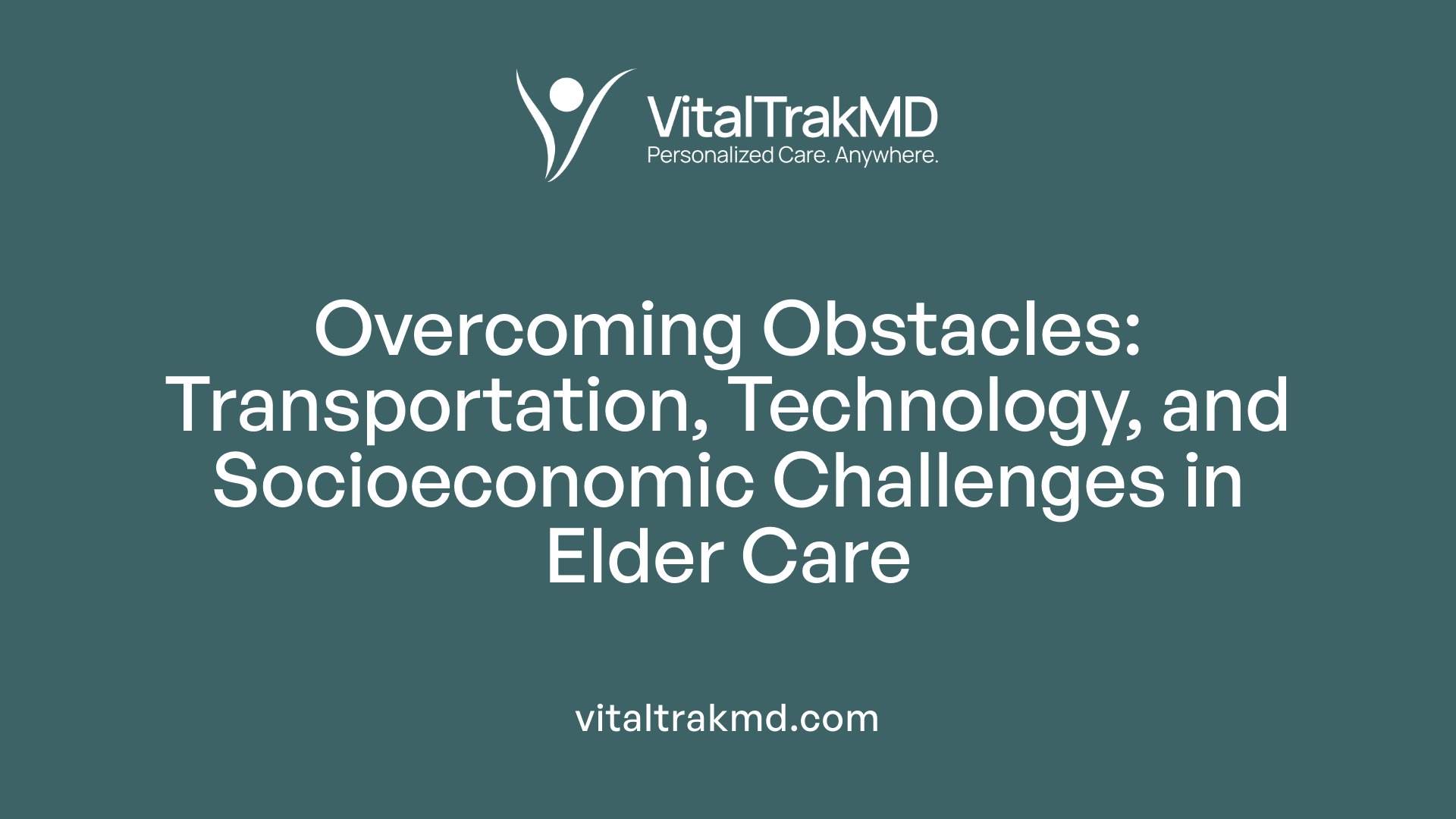Why Seniors Avoid Doctor Visits and How Hybrid Care Provides a Solution

Understanding the Shift in Senior Healthcare Engagement
As the population ages, ensuring effective, accessible healthcare for seniors becomes increasingly critical. Traditional face-to-face doctor visits often deter many older adults due to a variety of barriers, leading to suboptimal health outcomes. Meanwhile, hybrid healthcare models—integrating in-person and telehealth services—are emerging as promising solutions. This article explores why seniors tend to avoid traditional healthcare encounters and how innovative hybrid care approaches can address these challenges, improve health outcomes, and support aging in place.
Common Reasons for Seniors’ Healthcare Avoidance

What are common reasons seniors avoid traditional healthcare visits?
Many older adults choose not to visit healthcare providers for various reasons that go beyond simple accessibility issues. Psychological fears and emotional barriers greatly influence their decisions.
One of the most common concerns is fear of being diagnosed with a serious illness, which can lead to anxiety about the possible outcomes and further health implications. This fear often results in avoidance to delay potential distress.
Concerns about painful treatments or procedures also deter seniors from seeking care. The anticipation of discomfort or invasive interventions can be a significant barrier, especially for those who have had negative experiences in the past.
Fears related to loss of independence or becoming a burden to family members are prevalent among seniors. Many worry that seeking help might lead to increased dependence or institutional care, which can threaten their sense of autonomy.
Distrust in healthcare providers or communication barriers can further discourage visits. When seniors feel their concerns are not adequately heard or understood, their confidence in medical care diminishes.
Economic and practical factors such as financial constraints and transportation difficulties are tangible barriers that prevent many seniors from accessing care. Limited income, inadequate insurance coverage, or lack of reliable transportation can make healthcare visits seem daunting.
Safety concerns, including fear of exposure to illnesses like COVID-19 or previous negative healthcare experiences, also influence their avoidance behaviors. These safety fears can be compounded by sensory impairments, mobility limitations, or cognitive issues.
Lastly, perceptions of poor care quality, whether real or perceived, contribute to their reluctance. If seniors believe that healthcare providers do not meet their needs or that the care is ineffective, they may prefer to avoid visits altogether.
Overall, the combination of emotional fears, communication issues, safety concerns, and practical barriers creates a complex web that influences why many seniors avoid traditional doctor visits. Addressing these factors through tailored, accessible, and compassionate care can help mitigate avoidance and improve health outcomes.
Barriers Faced by Seniors in Healthcare Access

What barriers do seniors face in accessing healthcare?
Older adults encounter numerous obstacles that can impede their ability to receive adequate medical care. Transportation and mobility challenges are among the most common, especially for seniors living in rural or underserved communities where public transit options are limited and distances to medical facilities are vast.
The complexity of healthcare systems adds another layer of difficulty. Navigating appointments, insurance procedures, and specialist referrals can be overwhelming, leading to delays or avoidance of necessary care.
Socioeconomic and geographic disparities further restrict access. Low income, limited insurance coverage, and residence in rural areas with fewer healthcare providers result in reduced access to quality services and specialists.
Physical and sensory impairments, such as limited mobility, hearing loss, or visual impairments, often hinder seniors’ ability to attend in-person visits or effectively communicate with healthcare providers.
Support from caregivers and healthcare professionals is crucial, yet many seniors lack adequate assistance, which can cause anxiety and miscommunication.
The digital divide presents additional barriers. Many older adults are not familiar with or confident in using digital health tools and telemedicine platforms, which limits their ability to benefit from contemporary healthcare innovations.
Language and cultural barriers may also affect the quality of care, especially among minority populations. This can lead to misunderstandings, decreased trust, and lower healthcare utilization.
Addressing these barriers requires comprehensive strategies, including improving transportation services, simplifying healthcare navigation, expanding digital literacy programs, and ensuring culturally competent care. Such proactive approaches are vital to making healthcare more accessible and equitable for the aging population.
How Hybrid Care Models Improve Access for Elderly Patients

How can hybrid healthcare models improve access for elderly patients?
Hybrid healthcare models blend virtual and in-person services to expand care reach for older adults. During the COVID-19 pandemic, these approaches proved especially beneficial, allowing seniors to maintain regular contact with healthcare providers while minimizing exposure risks.
By utilizing virtual visits, seniors no longer need to travel long distances or navigate transportation barriers. This is particularly important in rural or underserved urban areas where access to healthcare facilities is limited. Programs such as Cleveland Clinic’s geriatric hybrid care project combine home visits with virtual assessments to identify safety concerns, evaluate cognition, and reconnect elderly patients with vital services.
These models facilitate timely interventions for chronic conditions, support post-discharge follow-up, and enhance early detection of health issues. The seamless integration of technology into clinical workflows encourages greater patient engagement and adherence to treatment plans.
Furthermore, hybrid care supports vulnerable populations, including those experiencing functional impairments or social isolation. It helps address disparities related to race, ethnicity, income, and geography by offering more equitable access to quality care. In essence, these models make healthcare more flexible, manageable, and personalized, leading to improved health outcomes for elderly patients.
Benefits of Hybrid Healthcare for Seniors

What are the benefits of hybrid healthcare for seniors?
Hybrid healthcare combines in-person visits with virtual care, creating a flexible and patient-centered approach that offers numerous advantages for older adults.
One of the primary benefits is improved access to care. Telehealth services enable seniors, especially those with mobility issues or residing in remote areas, to receive medical attention without needing to travel. This convenience reduces transportation burdens and can lessen caregiver strain.
Additionally, virtual visits facilitate easier management of chronic diseases and mental health concerns. Remote monitoring tools—such as smart devices and teleconsultations—allow for continuous oversight, early intervention, and personalized care plans.
Hybrid models also address important social determinants of health (SDOH), including housing, nutrition, and social support. Virtual screening and social care integration help identify and mitigate barriers that could otherwise compromise health outcomes.
Cost savings are another significant aspect. Reduced hospital visits, shorter emergency room stays, and decreased travel expenses contribute to more efficient resource use for healthcare systems and patients.
Most importantly, patients often report higher satisfaction due to the flexibility, ease of access, and feeling of being supported continuously. This approach fosters better engagement, adherence to treatment, and a sense of empowerment for seniors.
In essence, hybrid healthcare not only expands access and equity but also enhances the quality of care, making it a promising model for meeting the complex needs of the aging population.
Challenges in Implementing Hybrid Care for Seniors
What challenges are involved in implementing hybrid healthcare solutions for older adults?
Implementing hybrid healthcare models for seniors presents a range of obstacles that need careful consideration and strategic planning. One of the primary challenges involves technological barriers. Many older adults face difficulties with digital literacy, making it hard for them to navigate telehealth platforms confidently. Sensory impairments such as sight and hearing loss, along with age-related cognitive changes, can further complicate interactions with digital devices and platforms.
Usability issues also pose significant barriers. Complex interfaces, small text, and fragmented workflows can deter seniors from engaging fully with telehealth services. Beyond technology, social support plays a crucial role. The lack of assistance from healthcare providers or caregivers, or their resistance to adopting virtual care, can impede smooth integration of hybrid solutions.
Distrust in digital privacy and concerns about data security also influence older adults' willingness to use telemedicine. Many worry about personal information being compromised, which can create hesitation or refusal in adopting these tools.
Infrastructure disparities are another critical hurdle. Rural areas often lack reliable high-speed internet, essential for seamless video consultations. Low-income populations may also face challenges in affording necessary devices or internet subscriptions, exacerbating healthcare disparities.
Moreover, managing multiple chronic conditions, cognitive impairments, or disabilities complicates care coordination in hybrid models. Ensuring continuous, personalized care requires tailored strategies that include remote monitoring, caregiver involvement, and easy-to-access support systems.
Successful implementation depends on integrating these solutions into existing healthcare workflows. This includes training providers in digital health best practices, developing caregiver support networks, and designing systems that accommodate the physical, cognitive, and social needs of older adults.
Addressing these multifaceted challenges necessitates collaborative efforts among technology developers, healthcare organizations, and policymakers. Focused initiatives to improve accessibility, build trust, and foster patient-centered approaches are crucial for making hybrid healthcare a sustainable and equitable option for seniors.
Role of Telemedicine in Supporting Elderly Healthcare Needs
What role does telemedicine play in supporting elderly patients' healthcare needs?
Telemedicine has become an essential tool in managing the health of older adults, especially during the COVID-19 pandemic. It offers remote access to medical consultations, enabling seniors with mobility issues or those living in rural and underserved areas to connect with healthcare providers conveniently from home. This approach helps prevent health complications, reduces unnecessary hospital visits, and lowers healthcare costs.
Many older adults find telehealth beneficial for routine check-ups, managing chronic diseases like diabetes and heart conditions, and post-operative follow-ups. Virtual visits are particularly useful for follow-up care and minor health issues, providing timely interventions without the need for travel.
In addition to medical management, telemedicine facilitates social connection, helping seniors stay engaged with family and friends, which can ease feelings of loneliness and reduce stress and anxiety. Support services such as device training, multilingual assistance, and simplified technology platforms are crucial in overcoming barriers related to digital literacy and trust.
Despite some technical challenges, especially among those with sensory impairments or limited technological skills, the overall patient satisfaction remains high, with median scores indicating strong approval of virtual care.
Overall, telemedicine significantly enhances accessibility and customization of healthcare for older adults. It supports better chronic disease management, improves health outcomes, and promotes mental well-being, proving vital in comprehensive elderly care.
Impact of Hybrid Care on Health Outcomes and Satisfaction
How does hybrid healthcare impact health outcomes and patient satisfaction among seniors?
Hybrid healthcare models, which combine in-person visits with telemedicine and remote monitoring, have demonstrated positive effects on health outcomes among older adults. By enabling proactive management of chronic conditions such as diabetes and cardiovascular diseases, these models help maintain disease stability and prevent complications.
Research indicates that such approaches can significantly reduce frailty and lesser known geriatric syndromes. For example, integrating self-efficacy strategies and social interdependence in care plans can lead to the reversal of frailty, improved nutritional status, and enhanced physical function. These improvements contribute to better overall health and functional independence.
Additionally, hybrid care improves healthcare access by bridging racial, ethnic, and geographic disparities. Older adults in rural areas or minority groups often face barriers to in-person care, but hybrid models help mitigate these issues by extending specialist and primary care availability through virtual means.
Chronic disease management benefits notably from hybrid systems. For diabetics, continuous remote monitoring and frequent virtual check-ins enable sustained glycemic control, increase visit numbers, and reduce hospital admissions, all without adding the risk of in-person visits during health crises like the COVID-19 pandemic.
Overall, these flexible and comprehensive care options lead to higher patient satisfaction. Seniors value the convenience, personal attention, and ongoing engagement made possible by hybrid care, which aligns with their needs for accessible, personalized, and continuous health support.
In conclusion, adopting hybrid healthcare models enhances clinical outcomes, reduces disparities, and improves the overall care experience for seniors, fostering healthier aging and greater satisfaction.
Strategies to Promote Aging in Place via Hybrid Healthcare
What strategies can be used to promote aging in place through hybrid healthcare services?
To support older adults in aging in place, healthcare providers are increasingly adopting hybrid models that blend virtual and in-person care. These approaches prioritize seamless coordination among multidisciplinary teams, combining telehealth, community-based services, and home support. Technologies such as remote patient monitoring devices, virtual check-ins, and digital health platforms enable continuous oversight of health conditions, especially chronic diseases, reducing the need for hospital visits.
Home modifications and social supports play vital roles by creating safe living environments and addressing social determinants of health such as transportation, social engagement, and access to nutritious food. The integration of these elements helps maintain independence and safety, even for those with mobility or cognitive challenges.
Applying the 4Ms framework—What Matters, Medications, Mentation, and Mobility—offers a comprehensive approach to holistic care. This ensures treatment plans are aligned with individual preferences, cognitive health, medication management, and functional mobility.
Developing personalized, person-centered care pathways involves tailoring services like home-based primary care, virtual visits, and remote monitoring to each individual's needs. These customized strategies not only improve outcomes but also foster a sense of trust and empowerment.
By reducing hospitalizations and reliance on institutional care, these hybrid models enable older adults to enjoy a higher quality of life within familiar environments. The combination of innovative technologies, coordinated community efforts, and holistic care frameworks paves the way for sustainable aging in place, aligning healthcare delivery with personal preferences and social factors.
Innovative Healthcare Delivery Models for Seniors
What are the innovative healthcare delivery models tailored for aging populations?
To better serve older adults, especially those with mobility challenges or residing in rural areas, healthcare providers are creating new and flexible care models. One prominent approach includes home-based primary care and mobile clinics. These services bring medical care directly to seniors’ homes or communities, reducing the need for travel and making healthcare more accessible.
Community paramedicine programs are another innovative solution. Trained paramedics provide in-home assessments, minor treatments, and health education, fostering trust and improving patient communication. These programs are especially useful in reaching unattached or isolated seniors.
Virtual visits, facilitated by advanced remote monitoring devices, enable continuous management of chronic conditions, post-surgical follow-ups, and fall prevention strategies. These tools help prevent unnecessary hospital admissions by allowing early intervention.
A notable example is the Sheba Beyond virtual hospital in Israel. It combines in-person and remote hospital-level care, offering patients the choice between physical hospital beds and virtual beds at home. This hybrid setup reduces hospital strain and enhances convenience.
Further innovations include flexible hospital designs that feature fewer physical beds but incorporate high-tech virtual capabilities. These facilities support swift transitions between inpatient, outpatient, and home-based care, optimizing resource use and patient experience.
Overall, these diverse models aim to improve healthcare access, personalize treatments, and increase efficiency for the aging population. By integrating technology and community-based care, they address barriers faced by frail, socially isolated, or rural seniors, ensuring that healthcare is responsive to their unique needs.
Role of Digital Platforms and Integration in Hybrid Care
How do digital platforms support hybrid care models for seniors?
Digital health platforms like Amwell Converge™ play a pivotal role in transforming healthcare delivery for older adults by integrating in-person, virtual, and digital services into a cohesive system. These platforms facilitate smooth coordination between various care modalities, making hybrid care models more effective and accessible.
One of the core features of Amwell Converge™ is its ability to streamline workflows. It automates routine processes such as appointment scheduling, pre-visit testing, and follow-up communications, reducing administrative burdens for providers and improving patient convenience.
Integration with electronic health records (EHR) is another critical component. This allows healthcare professionals to access real-time, comprehensive patient data during virtual or in-person visits. Such seamless information sharing supports more accurate diagnosis, personalized treatment plans, and better management of chronic conditions.
Moreover, these platforms enable the implementation of automated care programs, including decision engines and intelligent conversations. These tools extend care beyond the hours of direct provider contact by promoting continuous engagement, monitoring, and timely interventions through digital behavioral health modules and virtual nursing support.
Supporting workflows is enhanced by features like digital behavioral health programs, which provide self-guided or coached mental health support, and specialty consults that bring expert care directly to the patient’s home or virtual setting.
By leveraging these advanced technological solutions, healthcare systems can boost patient engagement, improve quality of care, and ensure continuity. This is especially beneficial for seniors, who often have complex health needs and may face mobility or transportation barriers.
Overall, digital platforms such as Amwell Converge™ serve as the backbone of hybrid care models, enabling providers to deliver integrated, patient-centered care that adapts to individual preferences and clinical requirements.
Community and Policy Initiatives Supporting Elder Care Innovation
What community and policy initiatives support elder care innovation?
Various programs and policies are shaping the future of elder care, especially in underserved or rural areas. The Rural Aging Action Network exemplifies community-driven efforts to identify gaps in services, improve outreach, and develop transportation and social support systems. Such initiatives aim to enhance access to healthcare for older adults living in remote areas.
Policy measures further bolster these efforts through strategic workforce development. This includes scholarships, internships, and specialized training programs designed to prepare healthcare providers with skills in geriatric care. Addressing the stark shortage of physicians in rural zones—where only around 12% of doctors practice despite 20% of the population residing—is a priority.
Reforming long-term care involves expanding community-based services, improving safety standards in nursing homes, and promoting aging in place through integrated home support systems. These reforms help meet the preferences of many seniors to stay in familiar environments longer.
Addressing social determinants of health is also critical. Interventions target housing, nutrition, transportation, and social participation, thereby reducing disparities and fostering equity in elder care.
Funding and reimbursement strategies play a vital role in sustaining innovation. Enhanced reimbursement models for home visits and telehealth services ensure financial viability for providers adopting hybrid care approaches.
Together, these community efforts and policy initiatives foster innovation, improve system resilience, and promote equitable access—ensuring that aging populations receive comprehensive, person-centered care that adapts to modern healthcare challenges.
Global Examples of Hybrid Health Systems
What are global examples of hybrid health systems supporting seniors?
Across the world, innovative hybrid healthcare models have emerged to improve access and quality of care for older adults. One prominent example is Sheba Beyond, a virtual hospital in Israel. This platform combines remote hospital-level care with in-hospital services, allowing patients to be monitored and treated from their own homes while maintaining seamless integration with traditional hospital care.
In Italy, virtual ward programs are actively used to manage infectious diseases like COVID-19 and chronic illnesses remotely. These programs utilize remote monitoring devices and teleconsultations, significantly reducing hospital length of stay and associated costs. Patients receive ongoing care at home, which minimizes exposure and travel while supporting continuous health management.
Meanwhile, in the United States, the pandemic accelerated the adoption of telehealth, with some systems increasing virtual patient encounters up to 175 times compared to pre-pandemic levels. These expansions used platforms capable of supporting diverse services, from follow-ups to urgent care, illustrating the scalability and adaptability of hybrid models.
These global initiatives exemplify how blending virtual and in-person healthcare approaches can extend care access for aging populations. They demonstrate benefits such as reduced hospital admissions, enhanced chronic disease management, and more personalized patient experiences.
Lessons drawn from these systems underscore the importance of flexible, resilient technological infrastructures that can adapt to various health needs. Multidisciplinary teamwork, including medical professionals, technologists, and community-based providers, is crucial. Equally important are strategies to engage and educate patients about virtual care, building trust and digital literacy.
By adopting these principles, healthcare providers worldwide can develop hybrid systems that meet the complex needs of older adults, ensuring they receive timely, effective, and compassionate care outside traditional settings.
The Future of Elderly Healthcare and Policy Recommendations
What is the future outlook for elderly healthcare, and what policy changes are recommended?
The outlook for healthcare services catering to older adults is leaning toward innovative, flexible models that prioritize individual needs and promote equitable access. As the US population aged 65 and older is expected to reach 20% by 2030, healthcare systems must prepare to serve an increasingly large and diverse group.
One of the significant shifts involves expanding telehealth and hybrid care models, which combine in-person services with virtual visits. These approaches are especially beneficial for older adults with mobility issues, those living in rural or underserved areas, and individuals managing chronic conditions. Evidence suggests that these models not only improve access but also foster better patient engagement and management outcomes.
Policy reforms should focus on several strategic areas. First, investing in workforce preparation is crucial—training healthcare providers in geriatrics, telemedicine, and culturally competent care will strengthen service delivery. Supporting the infrastructure necessary for digital health, such as reliable broadband access and user-friendly platforms, is equally vital.
In addition, social determinants of health, like housing, transportation, nutrition, and social support, must be integrated into care planning. This holistic approach helps address disparities and promotes aging in place, enabling seniors to reside comfortably within their communities.
Promoting community-based solutions such as home health programs, community paramedicine, and mobile clinics can bridge gaps in access and reduce reliance on hospitals. These initiatives enhance preventative care, early intervention, and chronic disease management.
Moreover, expanding and improving digital health technologies—including remote monitoring devices, electronic health records integration, and tailored digital platforms—will facilitate continuous care and early detection of issues.
Overall, policies that incentivize these innovations, support community and home-based care, and prioritize equity will ensure that elder care adapts to demographic shifts. These measures will help create a sustainable, resilient healthcare system capable of meeting the complex needs of an aging population.
Conclusion: Embracing a Holistic Approach to Elderly Care
As the aging population continues to grow, healthcare systems must evolve to meet their complex needs. Integrating various care modalities—medical, behavioral, and social—into accessible, comprehensive systems is crucial for providing effective support to older adults.
Technology plays a vital role in this transformation. Telemedicine, remote monitoring, and digital health platforms help extend care beyond traditional settings, reaching homebound and rural seniors who face in-person visit barriers. These tools enable continuous management of chronic conditions, early intervention, and timely access to specialty care, all while minimizing travel and exposure risks.
Community support and services are equally important for fostering aging in place. Building collaborations among healthcare providers, local organizations, and social services can address social determinants of health, reduce social isolation, and improve overall well-being. Tailoring services to individual preferences and cultural contexts enhances engagement and satisfaction.
Finding the right balance between in-person and virtual visits is essential for delivering personalized, flexible, and effective care. Routine check-ups, complex evaluations, and procedures may require face-to-face interaction, while follow-ups, medication management, and minor concerns can be efficiently handled virtually.
Systemic reforms including workforce training, infrastructure investments, and policy initiatives are necessary for building sustainable elder care models. Supporting a skilled workforce, expanding access to technology, and addressing disparities related to race, income, and geography will promote equity.
By adopting a holistic approach that combines integrated systems, innovative technology, community engagement, and thoughtful policies, healthcare providers can create resilient and equitable elder care frameworks. These strategies not only improve health outcomes but also uphold dignity, independence, and quality of life for older adults.
The Path Forward for Senior Healthcare
As the demographic landscape shifts, embracing innovative hybrid care models becomes crucial to overcoming traditional barriers, enhancing health outcomes, and supporting independence among seniors. By integrating technology, community efforts, and systemic policy reforms, healthcare systems can create a more inclusive and effective future—one that respects the dignity, preferences, and diverse needs of aging populations. The evolution of elder care from avoidance to engagement hinges on removing barriers, leveraging digital advances, and fostering trust. Hybrid care offers a pathway toward equitable, accessible, and sustainable healthcare that empowers seniors to age in place with confidence and optimal health.
References
- Older adults' perspectives on primary care telemedicine during the ...
- Why hybrid care starts with the patient - Medical Economics
- Comparing In-Person Only, Telemedicine Only, and Hybrid Health ...
- Hybrid approach to telehealth effective in rural communities
- Closing the gap: Technology access and telehealth use among ...
- Telemedicine in primary care of older adults: a qualitative study
- How a hybrid approach to telehealth improves patient care in rural ...
- Virtual and in-person care merge for a healthier future | EY - US
- Helping Older Adults Age Well in Rural America
- Actualizing Better Health And Health Care For Older Adults
Recent articles
Want to Feel Better and Live Healthier?
Join hundreds of patients taking control of their health with personalized care that fits their life – not the other way around.
Rated 4.8/5 by 32+ customers







